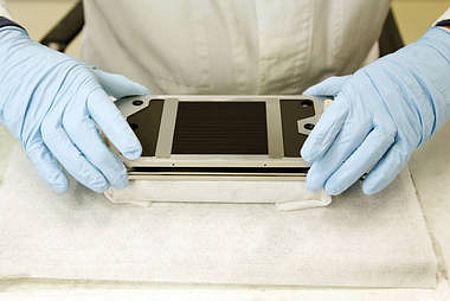ThyssenKrupp VDM develops improved high-performance alloy
for promising automotive and domestic fuel cell technology
23 . December 2011
ThyssenKrupp VDM and the Jülich Research Center (Forschungszentrum Jülich) have jointly developed an improved high-performance material for solid oxide fuel cells (SOFCs). The alloy known as Crofer 22 H has been brought to market maturity in a multi-year project conducted together with other industrial partners. By using the new material, it is possible to manufacture lightweight stacks, i.e. assemblies of multiple fuel cells, for use in vehicles among other things. "When we developed Crofer 22 H, one of the key objectives was to find a way of producing it on an industrial scale," emphasizes Dr Jutta Klöwer, Head of Research & Development at ThyssenKrupp VDM. "So we now have an alloy for fuel cell interconnects that is superior to steel but less expensive." And, as Dr Klöwer says, this holds both for industrial-scale energy supplies and for small, decentralized units in households or in automobiles.
Solid oxide or high-temperature fuel cells deliver clean energy in the form of heat or electricity at high efficiency and are therefore considered the innovative energy source of the future. In this kind of fuel cell technology, the required hydrogen-rich gas is produced by gasification of a liquid fuel such as diesel, petrol or methanol at temperatures up to 900°C. The conditions inside the fuel cell call for special materials: Crofer 22 H has been developed especially for use in high-temperature fuel cells. In addition to 20 to 24 percent chromium, its alloying constituents include tungsten, niobium, titanium and lanthanum. The new material possesses excellent corrosion resistance up to 900°C, good electrical conductivity of the oxide layer and high mechanical strength at service temperature. It also has good processing properties. The overall properties of Crofer 22 H were optimized under the research program "ZEUS" conducted by ThyssenKrupp VDM jointly with the Jülich Research Center.
In fuel cells, the high-performance alloy is used to make the so-called interconnects. These are intermediate steel plates which connect the individual fuel cells into a high-performance stack. The list of properties required of the material for this component is long: within the fuel cell, it has to be electrically conductive, corrosion resistant, mechanically stable and strong; it also has to have good processing properties and no negative effects on the cell as such. Crofer 22 H meets all these highly specific requirements. Another advantage is its thermal expansion behaviour, which matches that of the ceramic material used in the cell. This prevents the generation of mechanical stresses between the two materials which could damage the ceramic material. "Since the alloy is manufactured on an industrial scale, we can produce fuel cells more economically. Ultimately, it’s a question of cutting the system costs," explains Dr Robert Steinberger-Wilckens of the Jülich Research Center. "Since there is no need for vacuum induction melting in the production of Crofer 22 H, we’ve managed to significantly reduce production costs," Dr Jutta Klöwer stresses. Besides Crofer 22 H, other materials from ThyssenKrupp VDM also go into fuel cells. High-temperature nickel alloys, for example, are used in other SOFC assemblies such as heat exchangers and reformers.
Fuel cells can be used as auxiliary power units in cars, trucks, aircraft and ships, but there are also numerous stationary applications such as energy supply to buildings or in small and large combined heat and power plants. They are thus opening up new and more economic ways of generating heat and power for private households and vehicles. Given the high prices of fossil energy sources, this innovative development is a sustainable, cost-effective alternative for wide-spread use. Small, decentralized power plants are on the advance: they are enormously energy-efficient, and supply heat and electrical energy without producing any hazardous emissions. In short, they have all the prerequisites of a successful future-oriented technology.
ThyssenKrupp VDM (Werdohl) produces high-performance materials, including nickel alloys, special stainless steels and semi-finished products from zirconium and titanium. For over 80 years now, ThyssenKrupp VDM has been supplying sheet and plate, bars, billets, strip and wire to its key customers in plant construction, energy production, the oil and gas industry, electrical engineering and electronics as well as to the automotive and aerospace industries. ThyssenKrupp VDM (approx. 1,850 employees) has production locations in Germany at Werdohl, Altena, Unna, Siegen and Essen as well as two works in the USA. In addition, the company boasts a worldwide sales and distribution network.
Contact:
ThyssenKrupp AG
Erik Walner
Corporate Communications
Phone: +49 201 844-545130
Fax: +49 201 8456-545130
E-mai: erik.walner@thyssenkrupp.com
Your contact

